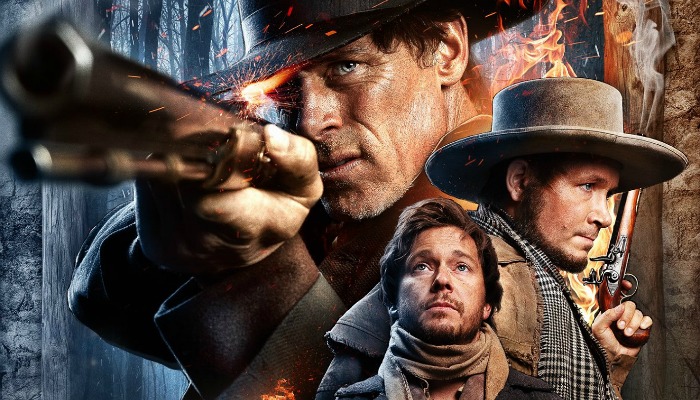
Liberty Jail has serious significance in Latter-day Saint history and culture — and, as the upcoming film Out of Liberty proves, not only for the reasons you might think.
When we think of Liberty Jail, chances are that our minds immediately conjure up Joseph’s desperate and heart-wrenching prayer offered in D&C 121. In it, he questions why the Lord has forsaken him — but what exactly caused him to wonder this? Many of us know Liberty Jail basics — i.e., the jail was tiny and Joseph and his friends were treated horribly — but we don’t know the full story.
Out of Liberty, from the writer and director of the popular Latter-day Saint thriller The Saratov Approach, seeks to explain the context of why Joseph was in Liberty Jail, what happened while he was there, and why it’s so imperative to Latter-day Saint history. It teaches us about the jailer’s (Samuel Tillery) ethical struggle, the local Missourians hatred of the Saints, and Joseph Smith’s suffering in jail.
And it does a pretty phenomenal job.
From Sidney Rigdon’s mental breakdown to the near-escape orchestrated by Porter Rockwell, Out of Liberty writer Stephen Dethloff explains what we need to know about Liberty Jail — and why Out of Liberty (in select theaters starting September 13) is a must-see.
Q: What is your official title in relation to the film?
A: My official title is writer. I’m one of 3 writers who worked on the film — myself; the director, Garrett Batty; and one of the producers, S. McKay Stevens. Garrett told me he would be interested in seeing a script for a movie that took place in Liberty Jail. I wrote that script, and then Garrett, McKay, and I did rewrites based off notes we gave each other on various drafts of the script.
Q: How was the idea to write this movie born?
A: Garrett and I wanted to make a movie based on events during the founding of The Church of Jesus Christ of Latter-day Saints. I wanted to tell a story about Joseph Smith. Garrett wanted to tell a story about Porter Rockwell. Both people happened to be in Liberty Jail — the latter just not as a prisoner. Also, Garrett wanted to see a movie about Liberty Jail because, you can film the movie on a smaller budget. Liberty jail is a small, two-story 14×14 ft. jail. That’s one location. You can film inside and outside of the jail — that’s two locations. You don’t need a lot of money for that. There are six prisoners inside the jail and a jailer. That’s seven actors. So you can make a good, high-quality film on a smaller, more independent budget.
Q: Why do you think this story is important and needs to be told?
A: I think the story is important because it provides a historical context for Joseph Smith’s revelations and his persecutions in Liberty Jail, and it provides a historical context for Joseph Smith himself. It also provides that context in a traditional, dramatic narrative so that it’s entertaining and exciting.
Most members of The Church of Jesus Christ of Latter-day Saints know that Joseph was in Liberty Jail for four months. But most people don’t know why he was there. This movie talks about that. Most people don’t know that while in jail, Joseph and his fellow prisoners tried to escape by tunneling out of the dungeon. They don’t know that Porter Rockwell snuck them the augers they used to tunnel out. They don’t know Sidney Rigdon went through a mental breakdown while in Liberty Jail. This movie takes all these stories — which will be new to most people — and puts them in a dramatic narrative structure so that everything makes sense and is entertaining. It’s a good movie.
Q: Did writing this movie — and the studying you did as you prepared it — change your perspective on Joseph Smith and what he went through at all?
Yes. I learned a lot about Joseph Smith from writing this movie. The thing that stands out to me the most is how Joseph repeatedly was taught to be patient and humble, and how he was repeatedly taught to submit his will to God’s will. [I was amazed by how] he would do that and encourage other people to do that. That’s a lesson that Sidney Rigdon didn’t or couldn’t or wouldn’t learn in Liberty Jail, which is unfortunate for him.
I just read a few days ago an essay by Orson F. Whitney called “Zion’s Future” [a segment of another talk, “Home Literature“]. In that essay, he talks about Joseph Smith. He says:
“[Joseph] knew that his people must progress, that their destiny demanded it; that culture is the duty of man, as intelligence the glory of God. Rough and rugged himself, as the granite boulders of yonder hills, typical of the firm, unyielding basis of God’s work, he knew, and his brethren around him knew, that on the rough, strong stones of which they were symbolical—the massive foundations of the past—the great Architect would rear the superstructure of the future; that the youth of Israel, their offspring, would be inspired to build upon the foundations of the fathers, and yet would differ from their fathers and mothers, as the foundations of a building, must differ from the walls and spires.”
This quote really hits home to me the themes and ideas that come out of Joseph in Liberty Jail. Joseph is a rough, strong stone — a foundational stone. And that’s his personality. But God made him become humble and submissive. He helped him submit his will to God’s own. And that’s the source of Joseph’s strength — it’s that seeming paradox of being a rough stone rolling down the hill, becoming a polished shaft.
Q: When people walk out of the theater, what’s the main thing you want them to take away from the film?
I mostly want people to walk out of the theater thinking, “Wow. I thought I knew Church history, but I really don’t. It turns out it is more faith-promoting, interesting, and exciting than I ever knew. And Joseph Smith was really cool.”
Q: How would you summarize the movie in three sentences?
This question is a good writing exercise!
“On the American frontier, Joseph Smith and five other prisoners’ attempts to escape the dungeon of Liberty Jail are repeatedly thwarted by deputy jailer Samuel Tillery. While keeping the prisoners inside, Samuel is also busy keeping angry mobs outside from breaking in and killing the prisoners. As Samuel tries to keep the prisoners safely in jail until their day in court arrives, he begins to wonder whether or not justice might be given to them better in some other way.”
♦
Sounds pretty amazing, huh?
The Internet Movie Database (IMDb) also provides a helpful summary of the movie:
“Winter 1839. LIBERTY, MISSOURI. Local jailer, Samuel Tillery (Jasen Wade) is tasked with watching Missouri’s most wanted men as they await their upcoming hearing. Caught between the local Missourians’ increased drive to remove the prisoners, and the prisoners’ desperate efforts to survive, Tillery is pushed beyond what any lawman can endure. Based on actual recorded accounts, OUT OF LIBERTY is an intense, evocative western, with an outcome you have to see to believe.”
Whether you’re a Church history novice or buff, this movie is an important addition to our Latter-day Saint library. And this much is sure: Come September 13th, it’ll be easy to find me.
I’ll be in theaters watching Out of Liberty.





